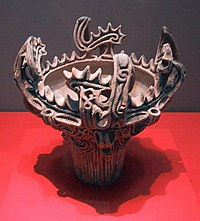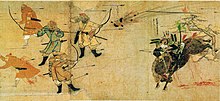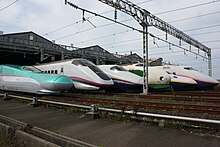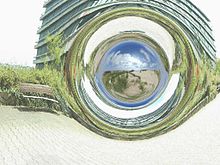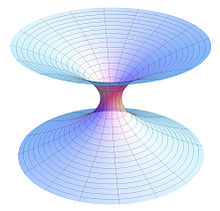Japan ( Japanese: 日本 Nihon or Nippon, officially 日本国 ![]() Nippon-koku or Nihon-koku) is an island nation in East Asia. Located in the Pacific Ocean, it lies to the east of the Sea of Japan, China, North Korea, South Korea and Russia, stretching from the Sea of Okhotsk in the north to the East China Sea and Taiwan in the south. The characters that make up Japan's name mean "sun-origin", which is why Japan is sometimes referred to as the "Land of the Rising Sun".
Nippon-koku or Nihon-koku) is an island nation in East Asia. Located in the Pacific Ocean, it lies to the east of the Sea of Japan, China, North Korea, South Korea and Russia, stretching from the Sea of Okhotsk in the north to the East China Sea and Taiwan in the south. The characters that make up Japan's name mean "sun-origin", which is why Japan is sometimes referred to as the "Land of the Rising Sun".
Japan is an archipelago of 6,852 islands. The four largest islands are Honshu, Hokkaido, Kyushu and Shikoku, together accounting for ninety-seven percent of Japan's land area. Japan has the world's tenth-largest population, with over 127 million people. The Greater Tokyo Area, which includes the de facto capital city of Tokyo and several surrounding prefectures, is the largest metropolitan area in the world, with over 30 million residents.
Archaeological research indicates that people lived in Japan as early as the Upper Paleolithic period. The first written mention of Japan is in Chinese history texts from the 1st century AD. Influence from other nations followed by long periods of isolation has characterized Japan's history. Since adopting its revised constitution in 1947, Japan has maintained a unitary constitutional monarchy with an emperor and an elected parliament called the Diet.
A major economic power, Japan has the world's third-largest economy by nominal GDP and by purchasing power parity. It is also the world's fourth largest exporter and fourth largest importer. Although Japan has officially renounced its right to declare war, it maintains an extensive modern military force in self-defense and peacekeeping roles. After Singapore, Japan has the lowest homicide (including attempted homicide) rate in the world. According to both UN and WHO estimates, Japan has the longest life expectancy of any country in the world. According to the UN, it has the third lowest infant mortality rate.
Etymology-
The English word Japan is an exonym. The Japanese names for Japan are Nippon ![]() listen (help·info) and Nihon
listen (help·info) and Nihon ![]() listen (help·info); both names are written using the kanji 日本. The Japanese name Nippon is used for most official purposes, including on Japanese yen, postage stamps, and for many international sporting events. Nihon is a more casual term and is used in contemporary speech. Japanese people refer to themselves as Nihonjin and to their language as Nihongo . Both Nippon and Nihonmean "sun-origin" and are often translated as Land of the Rising Sun. This nomenclature comes from Japanese missions to Imperial China and refers to Japan's eastward position relative to China. Before Nihon came into official use, Japan was known as Wa or Wakoku .
listen (help·info); both names are written using the kanji 日本. The Japanese name Nippon is used for most official purposes, including on Japanese yen, postage stamps, and for many international sporting events. Nihon is a more casual term and is used in contemporary speech. Japanese people refer to themselves as Nihonjin and to their language as Nihongo . Both Nippon and Nihonmean "sun-origin" and are often translated as Land of the Rising Sun. This nomenclature comes from Japanese missions to Imperial China and refers to Japan's eastward position relative to China. Before Nihon came into official use, Japan was known as Wa or Wakoku .
The English word for Japan came to the West via early trade routes. The early Mandarin or possibly Wu Chinese (吳語) word for Japan was recorded by Marco Polo as Cipangu. In modern Shanghainese, a Wu dialect, the pronunciation of characters 日本 'Japan' is Zeppen [zəʔpən]. The old Malay word for Japan, Jepang, was borrowed from a Chinese language, and this Malay word was encountered by Portuguese traders in Malacca in the 16th century. It is thought the Portuguese traders were the first to bring the word to Europe. It was first recorded in English in a 1565 letter, spelled Giapan.
History-
Prehistory and ancient history
An example of Jōmon pottery, 3000-2000 BC
A Paleolithic culture around 30,000 BC constitutes the first known habitation of Japan. This was followed from around 14,000 BC (the start of the Jōmon period) by a Mesolithic to Neolithic semi-sedentary hunter-gatherer culture, who include ancestors of both the contemporary Ainu people and Yamato people, characterized by pit dwelling and rudimentary agriculture. Decorated clay vessels from this period are some of the oldest surviving examples of pottery in the world. Around 300 BC, the Yayoi people began to enter the Japanese islands, intermingling with the Jōmon. The Yayoi period, starting around 500 BC, saw the introduction of practices like wet-rice farming, a new style of pottery, and metallurgy, introduced from China and Korea.
The Japanese first appear in written history in the Chinese Book of Han. According to the Records of Three Kingdoms, the most powerful kingdom on the archipelago during the 3rd century was called Yamataikoku. Buddhism was first introduced to Japan from Baekje, one of the Three Kingdoms of Korea, but the subsequent development of Japanese Buddhism was primarily influenced by China. Despite early resistance, Buddhism was promoted by the ruling class and gained widespread acceptance beginning in the Asuka period.
The Nara period of the 8th century marked the emergence of a strong Japanese state, centered on an imperial court in Heijō-kyō (modern Nara). In addition to the continuing adoption of Chinese administrative practices, the Nara period is characterized by the appearance of a nascent literature with the completion of the Kojiki (712) and Nihon Shoki (720). The smallpox epidemic of 735–737 is believed to have killed as much as one-third of Japan's population. In 784, Emperor Kammu moved the capital from Nara to Nagaoka-kyō before relocating it to Heian-kyō (modern Kyoto) in 794. This marked the beginning of the Heian period, during which a distinctly indigenous Japanese culture emerged, noted for its art, poetry and literature. Lady Murasaki's The Tale of Genji and the lyrics of Japan's national anthem Kimigayo were written during this time.
Feudal era
The Mongol invasions in 1274 and 1281 were successfully repelled
Japan's feudal era was characterized by the emergence and dominance of a ruling class of warriors, the samurai. In 1185, following the defeat of the Taira clan, samurai Minamoto no Yoritomo was appointed shogun and established a base of power in Kamakura. After Yoritomo's death, the Hōjō clan came to power as regents for the shoguns. The Zen school of Buddhism was introduced from China in the Kamakura period(1185–1333) and became popular among the samurai class. The Kamakura shogunate repelled Mongol invasions in 1274 and 1281, but was eventually overthrown by Emperor Go-Daigo. Go-Daigo was himself defeated by Ashikaga Takauji in 1336. The succeeding Ashikaga shogunate failed to control the feudal warlords (daimyo), and a civil war (the Ōnin War) began in 1467, opening the century-long Sengoku period("Warring States").
During the 16th century, traders and Jesuit missionaries from Portugal reached Japan for the first time, initiating direct commercial and cultural exchange between Japan and the West (Nanban trade). Oda Nobunaga conquered many other daimyo using European technology and firearms; after he was assassinated in 1582, his successor Toyotomi Hideyoshi unified the nation in 1590. Hideyoshi invaded Korea twice, but following defeats by Korean and Ming Chinese forces and Hideyoshi's death, Japanese troops were withdrawn in 1598.
Tokugawa Ieyasu served as regent for Hideyoshi's son Toyotomi Hideyori, using his position to gain political and military support. When open war broke out, he defeated rival clans in theBattle of Sekigahara in 1600. Ieyasu was appointed shogun in 1603 and established the Tokugawa shogunate at Edo (modern Tokyo). The Tokugawa shogunate enacted measures like buke shohatto as a code of conduct to control the autonomous daimyo. In 1639, the shogunate began the isolationist sakoku ("closed country") policy that spanned the two and a half centuries of tenuous political unity known as the Edo period. The study of Western sciences, known as rangaku, continued during this period through contact with the Dutch enclave at Dejima in Nagasaki. The Edo period also gave rise to kokugaku ("national studies"), the study of Japan by the Japanese.
Modern era
The Meiji Emperor
On March 31, 1854, Commodore Matthew Perry and the "Black Ships" of the United States Navy forced the opening of Japan to the outside world with the Convention of Kanagawa. Subsequent similar treaties with Western countries in the Bakumatsu period brought economic and political crises. The resignation of the shogun led to the Boshin War and the establishment of a centralized state nominally unified under the Emperor (the Meiji Restoration). Adopting Western political, judicial and military institutions, the Cabinet organized the Privy Council, introduced the Meiji Constitution, and assembled the Imperial Diet. The Meiji Restoration transformed the Empire of Japan into an industrialized world power that pursued military conflict to expand its sphere of influence. After victories in the First Sino-Japanese War (1894–1895) and the Russo-Japanese War (1904–1905), Japan gained control of Taiwan, Korea, and the southern half of Sakhalin. Japan's population grew from 35 million in 1873 to 70 million in 1935.
The early 20th century saw a brief period of "Taishō democracy" overshadowed by increasing expansionism and militarization. World War I enabled Japan, which joined the side of the victorious Allies, to widen its influence and territorial holdings. It continued its expansionist policy by occupying Manchuria in 1931; as a result of international condemnation of this occupation, Japan resigned from the League of Nations two years later. In 1936, Japan signed the Anti-Comintern Pact with Nazi Germany, and the 1940 Tripartite Pact made it one of the Axis Powers. In 1941, Japan negotiated the Soviet–Japanese Neutrality Pact.
The Empire of Japan invaded other parts of China in 1937, precipitating the Second Sino-Japanese War (1937–1945). In 1940, the Empire then invaded French Indochina, after which the United States placed an oil embargo on Japan. On December 7, 1941, Japan attacked the US naval base at Pearl Harbor and declared war on the United States, the United Kingdom and the Netherlands. This act brought the US into World War II and, on December 8, those three countries declared war on Japan. After the Soviet invasion of Manchuria and the atomic bombings of Hiroshima and Nagasaki in 1945, Japan agreed to an unconditional surrender on August 15. The war cost Japan and the rest of the Greater East Asia Co-Prosperity Sphere millions of lives and left much of the nation's industry and infrastructure destroyed. The Allies (led by the US) repatriated millions of ethnic Japanese from colonies and military camps throughout Asia, largely eliminating the Japanese empire and restoring the independence of its conquered territories. The Allies also convened the International Military Tribunal for the Far East on May 3, 1946 to prosecute some Japanese leaders for war crimes. However, the bacteriological research units and members of the imperial family involved in the war were exonerated from criminal prosecutions by the Supreme Allied Commander despite calls for trials for both groups.
In 1947, Japan adopted a new constitution emphasizing liberal democratic practices. The Allied occupation ended with the Treaty of San Francisco in 1952 and Japan was granted membership in the United Nations in 1956. Japan later achieved rapid growth to become the second-largest economy in the world. This ended in the mid-1990s when Japan suffered a major recession. In the beginning of the 21st century, positive growth has signaled a gradual economic recovery.
On March 11, 2011, Japan suffered the strongest earthquake in its recorded history. It had a magnitude of 9.0 and was aggravated by a tsunami, affecting the northeast area of Honshu, including Tokyo.
Geography
Topographic map
Japan has a total of 6,852 islands extending along the Pacific coast of Asia. The country, including all of the islands it controls, lies between latitudes 24° and 46°N, and longitudes 122° and 146°E. The main islands, from north to south, are Hokkaido, Honshū, Shikoku and Kyūshū. The Ryukyu Islands, including Okinawa, are a chain of islands south of Kyushū. Together they are often known as the Japanese Archipelago. About 73 percent of Japan is forested, mountainous, and unsuitable for agricultural, industrial, or residential use. As a result, the habitable zones, mainly located in coastal areas, have extremely high population densities. Japan is one of the most densely populated countries in the world.
The islands of Japan are located in a volcanic zone on the Pacific Ring of Fire. They are primarily the result of large oceanic movements occurring over hundreds of millions of years from the mid-Silurian to the Pleistocene as a result of the subduction of the Philippine Sea Plate beneath the continental Amurian Plate and Okinawa Plate to the south, and subduction of the Pacific Plate under the Okhotsk Plate to the north. Japan was originally attached to the eastern coast of the Eurasian continent. The subducting plates pulled Japan eastward, opening the Sea of Japan around 15 million years ago. Japan has 108 active volcanoes. Destructive earthquakes, often resulting in tsunamis, occur several times each century. The 1923 Tokyo earthquake killed over 140,000 people. The most recent major quakes are the 2004 Chūetsu earthquake and the 2011 Tōhoku earthquake, a 9.0-magnitude quake which hit Japan on March 11, 2011, and triggered a tsunami.
Climate
The climate of Japan is predominantly temperate, but varies greatly from north to south. Japan's geographical features divide it into six principal climatic zones: Hokkaido, Sea of Japan,Central Highland, Seto Inland Sea, Pacific Ocean, and Ryukyu Islands. The northernmost zone, Hokkaido, has a temperate climate with long, cold winters and cool summers.Precipitation is not heavy, but the islands usually develop deep snowbanks in the winter. In the Sea of Japan zone on Honshū's west coast, northwest winter winds bring heavy snowfall. In the summer, the region is cooler than the Pacific area, though it sometimes experiences extremely hot temperatures because of the foehn wind. The Central Highland has a typical inland climate, with large temperature differences between summer and winter, and between day and night; precipitation is light. The mountains of the Chūgoku and Shikoku regions shelter the Seto Inland Sea from seasonal winds, bringing mild weather year-round. The Pacific coast experiences cold winters with little snowfall and hot, humid summers because of the southeast seasonal wind. The Ryukyu Islands have a subtropical climate, with warm winters and hot summers. Precipitation is very heavy, especially during the rainy season.
The average winter temperature in Japan is 5.1 °C (41.2 °F) and the average summer temperature is 25.2 °C (77.4 °F). The highest temperature ever measured in Japan—40.9 °C (105.6 °F)—was recorded on August 16, 2007. The main rainy season begins in early May in Okinawa, and the rain front gradually moves north until reaching Hokkaido in late July. In most of Honshū, the rainy season begins before the middle of June and lasts about six weeks. In late summer and early autumn, typhoons often bring heavy rain.
Biodiversity
Sakura (Cherry blossom)
Japan has nine forest ecoregions which reflect the climate and geography of the islands. They range from subtropical moist broadleaf forests in the Ryūkyū and Bonin islands, to temperate broadleaf and mixed forests in the mild climate regions of the main islands, to temperate coniferous forests in the cold, winter portions of the northern islands. Japan has over 90,000 species of wildlife, including the brown bear, the Japanese macaque, the raccoon dog, and the Japanese giant salamander.
Environment
In the period of rapid economic growth after World War II, environmental policies were downplayed by the government and industrial corporations; as a result, environmental pollution was widespread in the 1950s and 1960s. Responding to rising concern about the problem, the government introduced several environmental protection laws in 1970. The oil crisis in 1973 also encouraged the efficient use of energy due to Japan's lack of natural resources. Current environmental issues include urban air pollution (NOx, suspended particulate matter, and toxics), waste management, water eutrophication, nature conservation, climate change, chemical management and international co-operation for conservation.
Japan is one of the world's leaders in the development of new environment-friendly technologies, and is ranked 20th best in the world in the 2010 Environmental Performance Index. As a signatory of the Kyoto Protocol, and host of the 1997 conference which created it, Japan is under treaty obligation to reduce its carbon dioxide emissions and to take other steps to curb climate change.
Politics
Emperor Akihito and Empress Michiko
Japan is a constitutional monarchy where the power of the Emperor is very limited. As a ceremonial figurehead, he is defined by the constitution as "the symbol of the state and of the unity of the people". Power is held chiefly by the Prime Minister of Japan and other elected members of the Diet, while sovereignty is vested in the Japanese people. Akihito is the current Emperor of Japan; Naruhito, Crown Prince of Japan, stands as next in line to the throne.
Japan's legislative organ is the National Diet, a bicameral parliament. The Diet consists of a House of Representatives with 480 seats, elected by popular vote every four years or when dissolved, and a House of Councillors of 242 seats, whose popularly-elected members serve six-year terms. There is universal suffrage for adults over 20 years of age, with a secret ballot for all elected offices. In 2009, the social liberal Democratic Party of Japan took power after 54 years of the liberal conservative Liberal Democratic Party's rule.
The Prime Minister of Japan is the head of government. The Prime Minister is appointed by the Emperor after being designated by the Diet from among its members, and must maintain the confidence of the House of Representatives to remain in office. The Prime Minister is the head of the Cabinet and appoints and dismisses the Ministers of State, a majority of whom must be Diet members. Naoto Kan was designated by the Diet to replace Yukio Hatoyama as the Prime Minister of Japan on June 2, 2010. Although the Prime Minister is formally appointed by the Emperor, the Constitution of Japan explicitly requires the Emperor to appoint whoever is designated by the Diet. Emperor Akihito formally appointed Kan as the country's 94th Prime Minister on June 8.
Historically influenced by Chinese law, the Japanese legal system developed independently during the Edo period through texts such as Kujikata Osadamegaki. However, since the late 19th century the judicial system has been largely based on the civil law of Europe, notably Germany. For example, in 1896, the Japanese government established a civil code based on a draft of the German Bürgerliches Gesetzbuch; with post–World War II modifications, the code remains in effect. Statutory law originates in Japan's legislature and has the rubber stamp of the Emperor. The Constitution requires that the Emperor promulgate legislation passed by the Diet, without specifically giving him the power to oppose legislation. Japan's court system is divided into four basic tiers: the Supreme Court and three levels of lower courts. The main body of Japanese statutory law is called the Six Codes.
Economy
The Tokyo Stock Exchange
From 1868, the Meiji period launched economic expansion in Japan as Meiji rulers embraced the market economy. Many of today's enterprises were founded at the time, and Japan emerged as the most developed nation in Asia. The period of overall real economic growth from the 1960s to the 1980s has been called a "Japanese miracle": it averaged 7.5 percent in the 1960s and 1970s, and 3.2 percent in the 1980s and early 1990s. Growth slowed markedly in the 1990s during what the Japanese call the Lost Decade, largely because of the after-effects of the Japanese asset price bubble and domestic policies intended to wring speculative excesses from the stock and real estate markets. Government efforts to revive economic growth met with little success and were further hampered by the global slowdown in 2000. The economy showed strong signs of recovery after 2005; GDP growth for that year was 2.8 percent, surpassing the growth rates of the US and European Union during the same period.
As of 2010, Japan is the third largest national economy in the world, after the United States and China, in terms of both nominal GDP and purchasing power parity. As of January 2011, Japan's public debt was more than 200 percent of its annual gross domestic product, the largest of any nation in the world. The service sector accounts for three quarters of the gross domestic product. Japan has a large industrial capacity, and is home to some of the largest and most technologically advanced producers of motor vehicles, electronics, machine tools, steel and nonferrous metals, ships, chemical substances, textiles, and processed foods. Agricultural businesses in Japan often utilize a system of terrace farming, and crop yields are high; 13 percent of Japan's land is cultivated. Japan accounts for nearly 15 percent of the global fish catch, second only to China.
As of 2010, Japan's labor force consisted of some 65.9 million workers. Japan has a low unemployment rate of around four percent. Almost one in six Japanese, or 20 million people, lived in poverty in 2007. Housing in Japan is characterized by limited land supply in urban areas; more than half of all Japanese live in suburbs or more rural areas, where detached houses are the dominant housing type.
Toyota, one of the world's largest automakers. Japan is the second-largest producer of automobiles in the world.
Japan's exports amounted to US$4,210 per capita in 2005. Japan's main export markets are China (18.88 percent), the United States (16.42 percent), South Korea (8.13 percent), Taiwan (6.27 percent) and Hong Kong (5.49 percent) as of 2009. Its main exports are transportation equipment, motor vehicles, electronics, electrical machinery and chemicals. Japan's main import markets as of 2009 are China (22.2 percent), the US (10.96 percent), Australia (6.29 percent), Saudi Arabia (5.29 percent), United Arab Emirates (4.12 percent), South Korea (3.98 percent) and Indonesia (3.95 percent). Its main imports are machinery and equipment, fossil fuels, foodstuffs (in particular beef), chemicals, textiles and raw materials for its industries. By market share measures, domestic markets are the least open of any OECD country. Junichiro Koizumi's administration began some pro-competition reforms, and foreign investment in Japan has soared.
Japan ranks 12th of 178 countries in the 2008 Ease of Doing Business Index and has one of the smallest tax revenues of the developed world. The Japanese variant of capitalism has many distinct features: keiretsu enterprises are influential, and lifetime employment and seniority-based career advancement are relatively common in the Japanese work environment. Japanese companies are known for management methods like "The Toyota Way", and shareholder activism is rare. Some of the largest enterprises in Japan include Toyota, Nintendo, NTT DoCoMo, Canon, Honda,Takeda Pharmaceutical, Sony, Panasonic, Toshiba, Sharp, Nippon Steel, Nippon Oil, and Seven & I Holdings Co. It has some of the world's largest banks, and the Tokyo Stock Exchange (known for its Nikkei 225 and Topix indices) stands as the second largest in the world by market capitalization. Japan is home to 326 companies from the Forbes Global 2000 or 16.3 percent (as of 2006).
Science and technology
Japan is a leading nation in scientific research, particularly technology, machinery and biomedical research. Nearly 700,000 researchers share a US$130 billion research and development budget, the third largest in the world. Japan is a world leader in fundamental scientific research, having produced fifteen Nobel laureates in either physics, chemistry or medicine, three Fields medalists, and one Gauss Prize laureate. Some of Japan's more prominent technological contributions are in the fields of electronics, automobiles, machinery, earthquake engineering, industrial robotics, optics, chemicals, semiconductors and metals. Japan leads the world in robotics production and use, possessing more than half (402,200 of 742,500) of the world's industrial robots.
The Japan Aerospace Exploration Agency (JAXA) is Japan's space agency; it conducts space, planetary, and aviation research, and leads development of rockets and satellites. It is a participant in the International Space Station: the Japanese Experiment Module (Kibo) was added to the station during Space Shuttle assembly flights in 2008. Japan's plans in space exploration include: launching a space probe to Venus, Akatsuki; developing the Mercury Magnetospheric Orbiter to be launched in 2013; and building a moon base by 2030. On September 14, 2007, it launched lunar explorer "SELENE" (Selenological and Engineering Explorer) on an H-IIA (Model H2A2022) carrier rocket from Tanegashima Space Center. SELENE is also known as Kaguya, after the lunar princess of The Tale of the Bamboo Cutter. Kaguya is the largest lunar mission since the Apollo program. Its purpose is to gather data on the moon's origin and evolution. It entered a lunar orbit on October 4, flying at an altitude of about 100 km (62 mi). The probe's mission was ended when it was deliberately crashed by JAXA into the Moon on 11 June 2009.
Infrastructure
Shinkansen or Bullet trains are a popular form of transport in Japan.
As of 2008, 46.4 percent of energy in Japan is produced from petroleum, 21.4 percent from coal, 16.7 percent from natural gas, 9.7 percent from nuclear power, and 2.9 percent from hydro power. Nuclear power produces 22.5 percent of Japan's electricity. Given its heavy dependence on imported energy, Japan has aimed to diversify its sources and maintain high levels of energy efficiency.
Japan's road spending has been extensive. Its 1.2 million kilometers of paved road are the main means of transportation. A single network of high-speed, divided, limited-access toll roads connects major cities and is operated by toll-collecting enterprises. New and used cars are inexpensive; car ownership fees and fuel levies are used to promote energy efficiency. However, at just 50 percent of all distance traveled, car usage is the lowest of all G8 countries.
Dozens of Japanese railway companies compete in regional and local passenger transportation markets; major companies include seven JR enterprises, Kintetsu Corporation, Seibu Railway and Keio Corporation. Some 250 high-speed Shinkansen trains connect major cities. Japanese trains are known for their punctuality. There are 173 airports in Japan; the largest domestic airport, Haneda Airport, is Asia's second-busiest airport. The largest international gateways are Narita International Airport, Kansai International Airport and Chūbu Centrair International Airport. Nagoya Port is the country's largest and busiest port, accounting for 10 percent of Japan's trade value.
